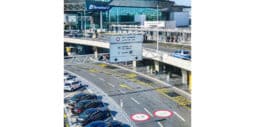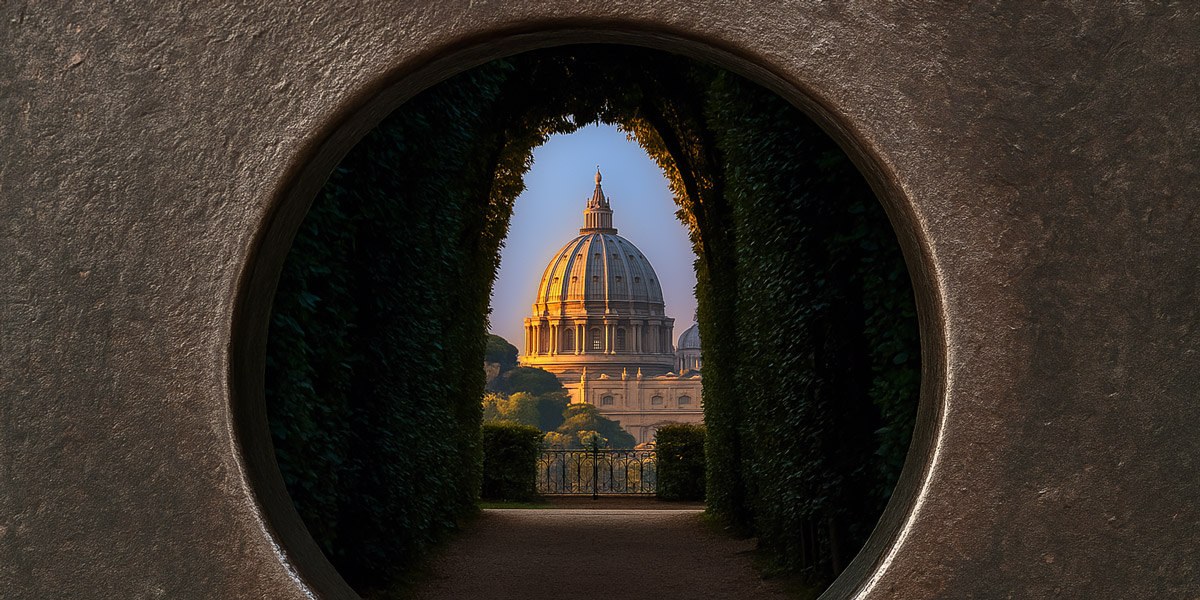

24833 views
Written by: Artur Jakucewicz

| Address | Piazza dei Cavalieri di Malta, 3, 00153, Rome |
|---|---|
| Website | www.orderofmalta.int |
Knights of Malta Keyhole — Rome’s most extraordinary peephole, famous for perfectly framing a laurel-lined tunnel and the distant dome of St Peter’s Basilica so that you glimpse three sovereign states in a single blink.
Read on for the story behind this tiny portal, advice on dodging the crowds, and the camera settings that turn a tricky subject into a postcard-ready image.
Contents
ToggleStep onto Piazza dei Cavalieri di Malta, and you will be in Italy.
Lean forward, and the heavy green doors place your eye on land belonging to the Sovereign Military Order of Malta, an extraterritorial micro-state.
Centered at the far end of the leafy corridor, the dome of St Peter’s rises inside Vatican City, about 1.5 mi (2.4 km) away.
Giovanni Battista Piranesi engineered this alignment in 1765 while redesigning the priory gardens for Cardinal Giovanni Battista Rezzonico, creating an optical bond between the Order and the Holy See it serves.
The Sovereign Military Order of Malta began in eleventh-century Jerusalem as a hospital brotherhood, later ruling the islands of Rhodes and Malta. When Napoleon seized Malta in 1798 the knights became a state without a territory, drifting through Europe until Pope Pius VII invited them to settle permanently in Rome.
The papacy already owned the old Templar precinct on the Aventine, so in 1834 it granted the knights the Villa del Priorato di Malta and the nearby Palazzo Malta on Via Condotti as headquarters and residence of the Grand Master.
That papal gift explains why a “Knights of Malta” enclave sits high above the Tiber rather than on the island that gave the Order its name. The link with the Holy See remains intimate: the Order is a lay religious order of the Catholic Church, its Grand Master swears obedience to the Pope, and the Vatican appoints a Cardinal Patron to safeguard spiritual life within the Order.
Read also about the House of the Knights of Rhodes.
Under the 1929 Lateran Pacts— the same agreements that created modern Vatican City—Italy recognized the Villa del Priorato and Palazzo Malta as extraterritorial sites. In legal terms they function like embassies: Italian police may not enter without permission, Italian taxes do not apply, and the Order issues its own vehicle plates and postage. That is why the plaque on the green doors proclaims “Sede Extraterritoriale” and why your single glance through the keyhole really does span three sovereign jurisdictions.
For a broader look at the neighborhood’s monasteries, secret gardens and sunset terraces, browse our full Aventine Hill Guide.
A close look at the dark-green portal reveals the site’s diplomatic status before you ever peer through the lock.
A bronze plaque spells out the Order’s full Italian name, crowned by its eight-pointed cross, and adds “Villa Magistrale — Sede Extraterritoriale,” confirming embassy-style immunity.
The wrought-iron knocker echoes 18th-century Maltese design, while a marble letter slot still accepts the Order’s mail and telegrams.
Just below the knocker, the worn bronze escutcheon guards the keyhole, its rim polished by decades of curious visitors.
Arrive between 7 and 9 a.m. when the Aventine is hushed, the light is gentle, and you can compose without a crowd breathing down your neck. By mid-morning, especially on weekends, the wait can stretch past twenty minutes; after dark, the line shortens, but autofocus struggles unless you carry a tripod—something security may forbid.
Most failed photos share the same culprit: automation. Phone and camera sensors often lock on the dark door, leaving the basilica bright and blurry, or meter the dome and plunge the hedge into darkness. Soft dawn light allows you to fine-tune focus and exposure before the next traveller steps up.
Author: Artur Jakucewicz
This website uses cookies. For more info read the cookies policy
Rome.us © 2025. Created with love by Roman experts and guides.